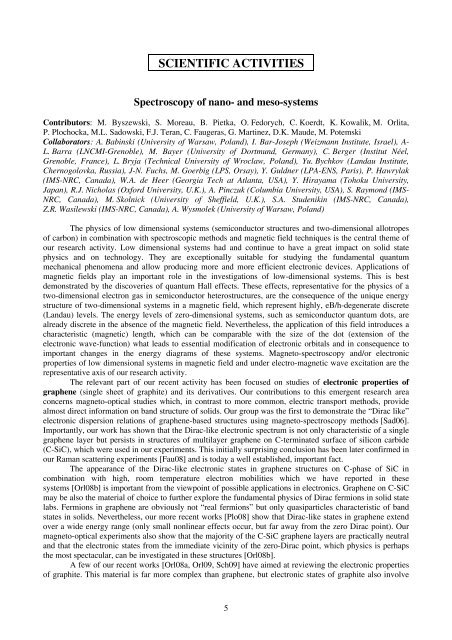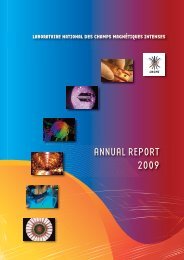Laboratoire National des Champs Magnétiques Pulsés CNRS – INSA
Laboratoire National des Champs Magnétiques Pulsés CNRS – INSA
Laboratoire National des Champs Magnétiques Pulsés CNRS – INSA
You also want an ePaper? Increase the reach of your titles
YUMPU automatically turns print PDFs into web optimized ePapers that Google loves.
SCIENTIFIC ACTIVITIES<br />
Spectroscopy of nano- and meso-systems<br />
Contributors: M. Byszewski, S. Moreau, B. Pietka, O. Fedorych, C. Koerdt, K. Kowalik, M. Orlita,<br />
P. Plochocka, M.L. Sadowski, F.J. Teran, C. Faugeras, G. Martinez, D.K. Maude, M. Potemski<br />
Collaborators: A. Babinski (University of Warsaw, Poland), I. Bar-Joseph (Weizmann Institute, Israel), A-<br />
L. Barra (LNCMI-Grenoble), M. Bayer (University of Dortmund, Germany), C. Berger (Institut Néel,<br />
Grenoble, France), L. Bryja (Technical University of Wroclaw, Poland), Yu. Bychkov (Landau Institute,<br />
Chernogolovka, Russia), J-N. Fuchs, M. Goerbig (LPS, Orsay), Y. Guldner (LPA-ENS, Paris), P. Hawrylak<br />
(IMS-NRC, Canada), W.A. de Heer (Georgia Tech at Atlanta, USA), Y. Hirayama (Tohoku University,<br />
Japan), R.J. Nicholas (Oxford University, U.K.), A. Pinczuk (Columbia University, USA), S. Raymond (IMS-<br />
NRC, Canada), M. Skolnick (University of Sheffield, U.K.), S.A. Studenikin (IMS-NRC, Canada),<br />
Z.R. Wasilewski (IMS-NRC, Canada), A. Wysmolek (University of Warsaw, Poland)<br />
The physics of low dimensional systems (semiconductor structures and two-dimensional allotropes<br />
of carbon) in combination with spectroscopic methods and magnetic field techniques is the central theme of<br />
our research activity. Low dimensional systems had and continue to have a great impact on solid state<br />
physics and on technology. They are exceptionally suitable for studying the fundamental quantum<br />
mechanical phenomena and allow producing more and more efficient electronic devices. Applications of<br />
magnetic fields play an important role in the investigations of low-dimensional systems. This is best<br />
demonstrated by the discoveries of quantum Hall effects. These effects, representative for the physics of a<br />
two-dimensional electron gas in semiconductor heterostructures, are the consequence of the unique energy<br />
structure of two-dimensional systems in a magnetic field, which represent highly, eB/h-degenerate discrete<br />
(Landau) levels. The energy levels of zero-dimensional systems, such as semiconductor quantum dots, are<br />
already discrete in the absence of the magnetic field. Nevertheless, the application of this field introduces a<br />
characteristic (magnetic) length, which can be comparable with the size of the dot (extension of the<br />
electronic wave-function) what leads to essential modification of electronic orbitals and in consequence to<br />
important changes in the energy diagrams of these systems. Magneto-spectroscopy and/or electronic<br />
properties of low dimensional systems in magnetic field and under electro-magnetic wave excitation are the<br />
representative axis of our research activity.<br />
The relevant part of our recent activity has been focused on studies of electronic properties of<br />
graphene (single sheet of graphite) and its derivatives. Our contributions to this emergent research area<br />
concerns magneto-optical studies which, in contrast to more common, electric transport methods, provide<br />
almost direct information on band structure of solids. Our group was the first to demonstrate the “Dirac like”<br />
electronic dispersion relations of graphene-based structures using magneto-spectroscopy methods [Sad06].<br />
Importantly, our work has shown that the Dirac-like electronic spectrum is not only characteristic of a single<br />
graphene layer but persists in structures of multilayer graphene on C-terminated surface of silicon carbide<br />
(C-SiC), which were used in our experiments. This initially surprising conclusion has been later confirmed in<br />
our Raman scattering experiments [Fau08] and is today a well established, important fact.<br />
The appearance of the Dirac-like electronic states in graphene structures on C-phase of SiC in<br />
combination with high, room temperature electron mobilities which we have reported in these<br />
systems [Orl08b] is important from the viewpoint of possible applications in electronics. Graphene on C-SiC<br />
may be also the material of choice to further explore the fundamental physics of Dirac fermions in solid state<br />
labs. Fermions in graphene are obviously not “real fermions” but only quasiparticles characteristic of band<br />
states in solids. Nevertheless, our more recent works [Plo08] show that Dirac-like states in graphene extend<br />
over a wide energy range (only small nonlinear effects occur, but far away from the zero Dirac point). Our<br />
magneto-optical experiments also show that the majority of the C-SiC graphene layers are practically neutral<br />
and that the electronic states from the immediate vicinity of the zero-Dirac point, which physics is perhaps<br />
the most spectacular, can be investigated in these structures [Orl08b].<br />
A few of our recent works [Orl08a, Orl09, Sch09] have aimed at reviewing the electronic properties<br />
of graphite. This material is far more complex than graphene, but electronic states of graphite also involve<br />
5







